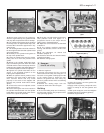
9 Pistons/connecting rods -
removal and refitting
3
1 Remove the cylinder head as described in
Section 7.
2 Remove the sump pan as described in
Section 8.
3 Undo and remove the big-end cap retaining
bolts and keep them in their respective order
for correct refitting.
4 Check that the connecting rod and big-end
bearing cap assemblies are correctly marked.
Normally the numbers 1-4 are stamped on
adjacent sides of the big-end caps and
connecting rods, indicating which cap fits on
which rod and which way round the cap fits.
The numbers are located on the sides of the
rod and cap furthest away from the camshaft.
5 If numbers are not evident, then use a sharp
file to make mating marks across the rod/cap
joint. One line for connecting rod No. 1, two
for connecting rod No. 2 and so on. This will
ensure that there is no confusion later as it is
most important that the caps go back in the
correct position on the connecting rods from
which they were removed. No. 1 piston should
be at the crankshaft pulley end of the engine.
6 If the big-end caps are difficult to remove
they may be gently tapped with a soft-faced
hammer.
7 To remove the shell bearings, press the
bearing opposite the groove in both the
connecting rod and the connecting rod caps
and the bearings will slide out easily.
8 Keep the shells with their original cap or rod
if the bearings are not being renewed.
9 Withdraw the pistons and connecting rods
upwards and ensure that they are kept in the
correct order for replacement in the same
bore.
10 If the cylinder has a wear ridge at its upper
end then this may make it difficult to remove
the piston. In this event, relieve the sharp
edge of the ridge by scraping.
11 Dismantling the pistons is described in
Section 18, paragraph 17.
12 Lay the piston and connecting rod
assemblies in the correct order ready for
refitting into their respective bores.
13 With a wad of clean non-fluffy rag wipe
the cylinder bores clean.
14 Position the piston rings so that their gaps
are 120º apart and then lubricate the rings.
15 Wipe clean the connecting rod half of the
big-end bearing and the underside of the shell
bearing. Fit the shell bearing in position with
its locating tongue engaged with the
corresponding groove in the connecting rod.
16 Fit a piston ring compressor to the top of
the piston, making sure it is tight enough to
compress the piston rings.
17 Using a piece of fine wire double check
that the little jet hole in the connecting rod is
clean.
18 The pistons, complete with connecting
rods, are fitted to their bores from above. The
number stamped on the connecting rod must
face away from the camshaft with the arrow
on the piston crown pointing towards the
timing cover.
19 With the base of the piston ring compressor
resting on the cylinder block, apply the wooden
handle of a hammer to the piston crown, strike
the hammer head with the hand and drive the
piston/rod into its bore (photo).
20 Draw the rod, complete with shell bearing
down onto its crankpin.
21 Generously lubricate the crankpin journals
with engine oil, and turn the crankshaft so that
the crankpin is in the most advantageous
position for the connecting rod to be drawn
into it.
22 Wipe clean the connecting rod bearing
cap and back of the shell bearing and fit the
shell bearing in position ensuring that the
locating tongue at the back of the bearing
engages with the locating groove in the
connecting rod cap.
23 Generously lubricate the shell bearing and
offer up the connecting rod bearing cap to the
connecting rod (photo).
1•12 903 cc engine
9.23 Big-end cap9.19 Fitting a piston/connecting rod
Fig. 1.8 Piston/connecting rod components (Sec 9)
1 Bolt
2 Connecting rod
3 Oil control ring
4 Compression ring
(stepped at base)
5 Compression ring
(marked TOP)
6 Gudgeon pin
7 Piston gudgeon pins
8 Big-end shell bearings
8.7B Sump pan nut, bolts and washers


















